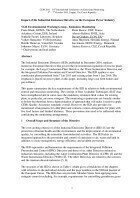Air Monitoring
Impact of the Industrial Emissions Directive on the European Power Industry
Dec 12 2014
Author: VGB Environmental Working Group - Emissions Monitoring on behalf of CEM
Abstract
The Industrial Emissions Directive (IED), published in December 2010, replaces numerous European Directives that govern the environmental regulation of process plant; for example, the Large Combustion Plant Directive, the Waste Incineration Directive and the Integrated Pollution Prevention and Control Directive. The IED applies to new combustion plant permitted from 7 Jan 2013 and existing plant from 1 Jan 2016. The emphasis is placed on power plant, in this paper, including large coal fired boilers and gas turbines.
This paper summarises the key requirements of the IED in relation to both environmental control and emissions monitoring. The concept of Best Available Techniques (BAT) has been strengthened and in some cases the mandatory emission limit values for existing plant, in particular, are more stringent. The monitoring requirements are broadly similar to before but there has been a harmonisation of approach that will make it easier to apply CEMs Quality Assurance standards overall. However, the IED also provides for transitional arrangements for older plant and contains various derogations for plant with low load factors and limited lifetimes. These provisions also need to be addressed when considering the monitoring arrangements.
1 Overall Scope and Structure of the Directive
The over-arching objectives of the Industrial Emissions Directive (IED) [1] are the protection of human health and the environment, and the improvement of environmental quality, by controlling the emissions from industrial activities. The IED takes an integrated approach to the prevention and control of emissions to air, water and land in addition to waste management, energy efficiency and accident prevention. The IED supersedes and harmonises the requirements of the Integrated Pollution Prevention and Control (IPPC) Directive and those of six other Directives related to industrial emissions, including the Large Combustion Plant Directive (LCPD) [3] and the Waste Incineration Directive (WID) [4]. The other Directives are related to the solvents and the titanium dioxide industries [5, 6]. The structure of the IED is shown in Table 1 which gives a breakdown of the chapters with reference to the individual Articles and the page numbers in the Official Journal of the European Union. The IED does not preclude Member States from applying more stringent controls including, for example, requirements for controlling greenhouse gases which are excluded from the scope of the IED in relation to the EU Emissions Trading Scheme. The IED does not apply to Research & Development activities or the testing of new products and processes within specified time constraints.
Digital Edition
AET 27.4 November 2023
November 2023
In This Edition Business News - Global sales of unique connected personal and area gas monitors reach over $2 million - nke Group announces the acquisition of Aquaread (UK) - Valeport suppo...
View all digital editions
Events
Nov 12 2023 Louisville, KY, USA
Nov 14 2023 Jakarta, Indonesia
Nov 14 2023 Valencia, Spain
Nov 14 2023 Karachi, Pakistan
Air Quality Measurement Methods and Tecnology
Nov 14 2023 Durham, NC, USA















